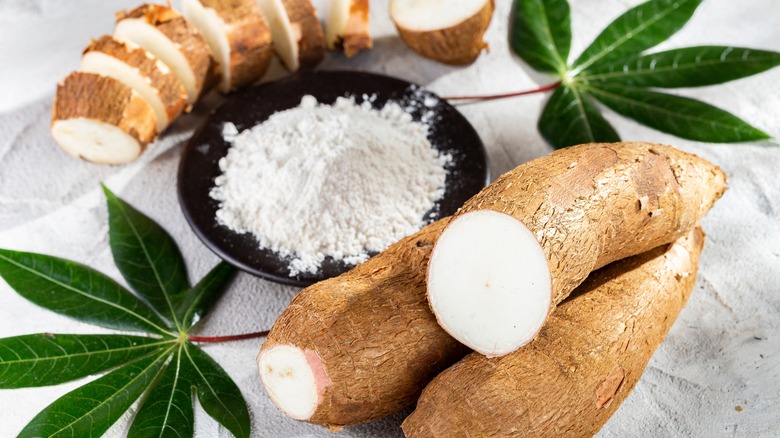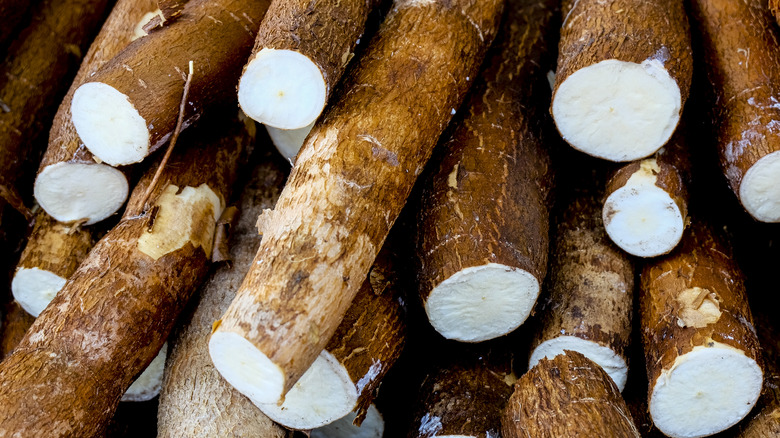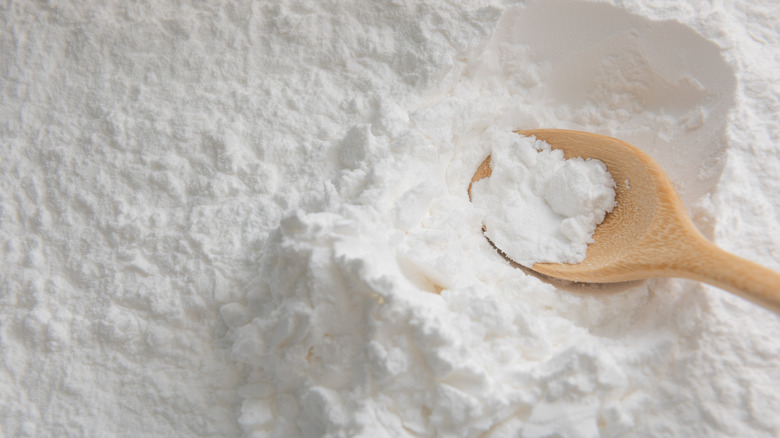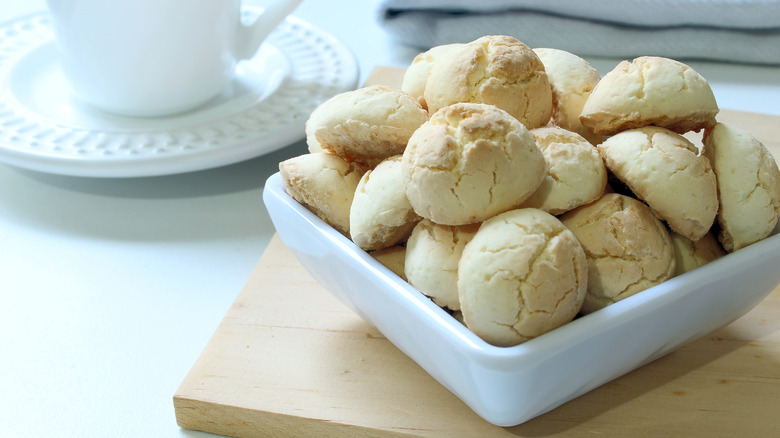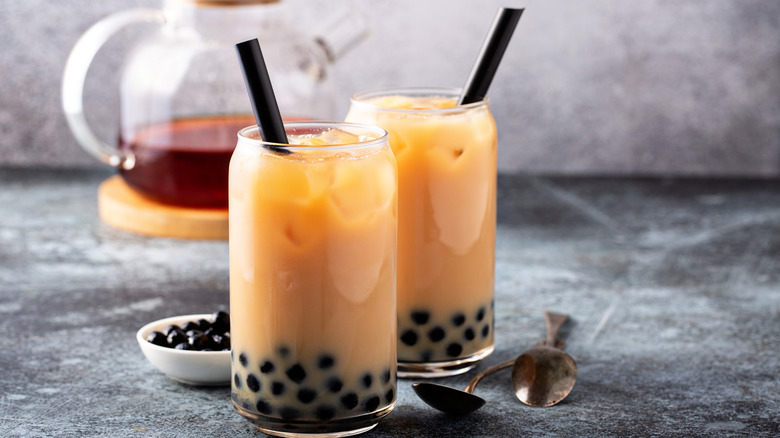Tapioca Vs. Cassava Flour: What's The Difference?
Flour is no longer a one-size-fits-all ingredient, with the standard all-purpose white version sharing supermarket shelf space with whole wheat, semolina, self-rising, unbleached, baking and cake flours, and more. And that's just counting the wheat-based ones. The choices expand to include flours made with different grains, such as rye and barley, and even venture outside the grain categories altogether. Cooking and baking get interesting, experimental, and surprisingly tasty when opening your kitchen to flours such as tapioca and cassava.
It's fascinating to note the fact that tapioca and cassava flour come from the very same cassava plant, leading to misconceptions about them having the same taste, texture, or application. Nothing could be further than the truth.
While both flours derive from cassava roots, tapioca flour is made only from the starch obtained from the root's pulp. Cassava flour, on the other hand, comes from the entire root. As you can imagine, those characteristics inform the results of whatever recipe they enter.
What is cassava flour?
Cassava is a tropical or subtropical tuber vegetable from the belowground portion of the cassava shrub, botanically known as Manihot esculenta. The plant has several monikers depending on location, including yuca in South America where it's a staple food. Cassava is also a staple in Africa. Apart from making flour, the root is typically consumed in similar ways to a sweet potato, either boiled, baked, fried, or mashed.
As cassava flour comes from the entire root, it's a more robust flour than its tapioca counterpart. Cassava flour is rich in fiber with a bit of a nutty flavor. When peeled, dried, and ground, the flour becomes a universally valuable component of bread and baked goods, and is also a versatile thickener. The cassava plant in raw form contains small amounts of cyanide, so this process also helps removes potentially dangerous levels of the harmful chemical compound.
Since cassava plants regenerate post-harvest with no need for new planting, the flour made from its roots is an affordable, hearty, high-carbohydrate, and nutritious sustenance food. A single cup of cassava flour harbors nearly enough vitamin C to meet the recommended daily values, according to WebMD. It can also aid in digestive and gut health, and it's gluten-free, making it increasingly popular for those with dietary restrictions.
What is tapioca flour?
Though tapioca flour and cassava flour both originate from the cassava plant's roots, the tapioca version is powdery and light rather than fibrous and dense. It's essentially a starch and is often referred to as such, appearing in some recipes as simply tapioca starch. It comes from the pulp of the cassava root, extracted by a laborious practice known as washing and pulping.
This process removes most all the nutritional value, including the beneficial fiber. But with its touch of sweetness and silky smooth consistency, tapioca flour makes for a coveted ingredient in sauces and puddings, particularly the well-known one bearing its name: tapioca pudding.
Tapioca is available in the usual flour form, which is powdered and scoopable for standard recipes, but it's also sold as tapioca flakes or pearls, sometimes known as tapioca balls. These pearls can easily be made at home using only tapioca flour and boiling water.
For baking, cassava is a go-to wheat flour swap
The most prominent use of cassava flour is for creating baked goods, particularly with the rising popularity of gluten-free eating. Some chefs and nutritionists consider it an easy substitute for wheat flour, adaptable to any recipe. However, there are some things to consider.
Since cassava flour is more dense than wheat flour, it tends to absorb liquids at a greater rate, which can leave your cookies or cakes too dry unless you add more of whatever liquid the recipe requires. Experiment with the amount of cassava flour needed as a replacement in a recipe until you find the perfect consistency. Though recall that cassava flour will add a slightly nutty, earthy flavor and its high fiber content may necessitate foregoing other thickening agents in the ingredient list.
Baked goods such as desserts aren't the only culinary application for cassava flour. Because of its inherent binding qualities, this flour helps produce a sticky dough for easy use in traditional breads, flatbreads, flour tortillas, and even savory pot pies and potstickers. It works well in thick sauces such as mole or gravy, and stands up as a batter for frying fish, chicken, and vegetables.
Tapioca flour shines as a thickener (and makes boba)
Cooking with tapioca flour is similar to cassava flour in many ways, particularly as a valuable substitute for wheat in gluten-free eating. It's also used as a thickening agent in many dishes, working in a similar way to cornstarch. Tapioca flour can generally be substituted for cornstarch in a 2:1 ratio of tapioca flour to cornstarch.
Tapioca is also known for creating light fluffiness and a bit of chewiness in baked goods. Because it has no odor or distinctive taste, it serves as a neutral base for most dishes, including sauces and stews, without altering the desired flavor. The starch can provide structure for crusts or pastries and a creamy thickness to sweet pie fillings or savory gravy-based cottage pies.
It's hard to imagine a world without tapioca pudding, and fortunately, you don't have to. That's because tapioca flour is readily available either in supermarkets or online venues, including in the form of pearls or balls. They're exactly how they sound: tiny, round, white balls made from starchy tapioca flour. Though you can purchase them white and unsweetened, it's common to find them with added brown sugar, turning them a darker shade. They're also known in some circles as boba pearls, as they're a primary component of boba, also called bubble tea.
